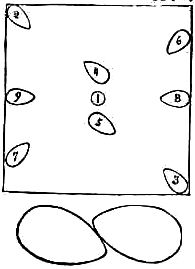



I RECENTLY CAME across a vividly written description of the fifteenth century craze for gambling, wherein among other games of skill or chance upon which the cavaliers were wont to bet so recklessly, mention was made of the sport of laying eggs upon a cloth, Here possibly was the true solution of the Columbus egg story, which despite its clever moral has always seemed too tame for such a fierce period. I saw that there was a pretty principle involved and present it as a clever souvenir of the fifteenth century, which differs from ordinary tricks and puzzles in that it calls for ingenious and original lines of thought, instead of experimental methods. As a matter of fact, in place of a practical demonstration, our puzzlists are merely called upon to exercise their wits in suggesting the best theory or principle whereby to solve the problem, for a clever person should guess the puzzle from the picture.
It is simply a game to be played between two opponents placing eggs alternately upon a square napkin in order to see who can win by placing the last egg. After an egg is placed it must not be moved or touched by another one, but as the size of the napkin or the eggs, as well as the variable distances which may occur between them, is of no importance, it would look as if the question of placing the last egg was a matter of luck or chance, and yet the winning trick, as the great navigator remarked, ŌĆ£is the easiest thing m the world when you are shown how!ŌĆØ
The secret of winning in a contest to see who can place the last egg upon a square napkin as described in the Columbus puzzle, turns upon placing the first egg exactly in the center of the napkin, as shown in the square diagram. Then, no matter where your opponent places an egg, duplicate his play on the opposite in a direct line through egg No. 1. The numbers given illustrate the beginning of the game, proceeding in regular order of play, viz.:
1, 2, 3, 4, 5, 6, 7, 8, 9, etc.
The placing of the first egg in the center would not win, if simply laid on the table, for, owing to the oval form of the egg, the second player might place an egg in close proximity to the conical end, as shown in the last illustration, which could not: be duplicated.
The only way to win, therefore, as discovered by the great navigator, according to popular history, is to flatten one end of the first egg played so as to make it stand erect, so as to represent a circle.
This puzzle, as previously explained, was not given for practical demonstration, but just to develop the gray matter in the brain.

2. A CHARADE.
When whole what sweetness I exhale,
Beheaded, numbers use me,
Restore my head, and take the tail,
To dress but few refuse me.
Ans. 16, 9, 14, 11.
PINK
3. A REBUS.
Complete IŌĆÖm an eastern trading mart,
Curtail, and of poems I form a part,
Again curtail, and youŌĆÖll quickly see,
Affected phrases and tones in me;
Curtail once more, and I stand revealŌĆÖd
A welcome guest in the harvest, field.
Cypher Ans. 3, 1, 14, 20, 15, 14.
CANTON
4. A CHARADE.
My firstŌĆÖs a public kind of carriage;
My second oft results from marriage;
My whole is useful all alow,
Though kicked and trampled anyhow!
Cypher Ans. 3, 1, 18, 16, 5, 20.
CARPET
6. A CHARADE.
My hoarding firstŌĆÖs no wiser, you will own;
My nextŌĆÖs a portion of each ladyŌĆÖs gown,
Should you grammerians, not content with this,
A different, kind of definition wish,
ŌĆśTis here, an article my first youŌĆÖll find;
My next a pronoun of The plural kind,
When pious thoughts your hearts with warmth inspire,
Sweet bursts my whole from every sacred choir.
Ans 1, 14, 20, ŌĆ”8, 5, 13, and 1, 14ŌĆ”20, 8, 5, 13.
ANTŌĆ”HEM and ANŌĆ”THEM
The answer to this charade might be her, hen, lady, or sultana, but there is a better word, so try and find it. We might also reverse the proposition and say there is a word of feminine gender, curtail it and it becomes a feminine one.
[Page 169]